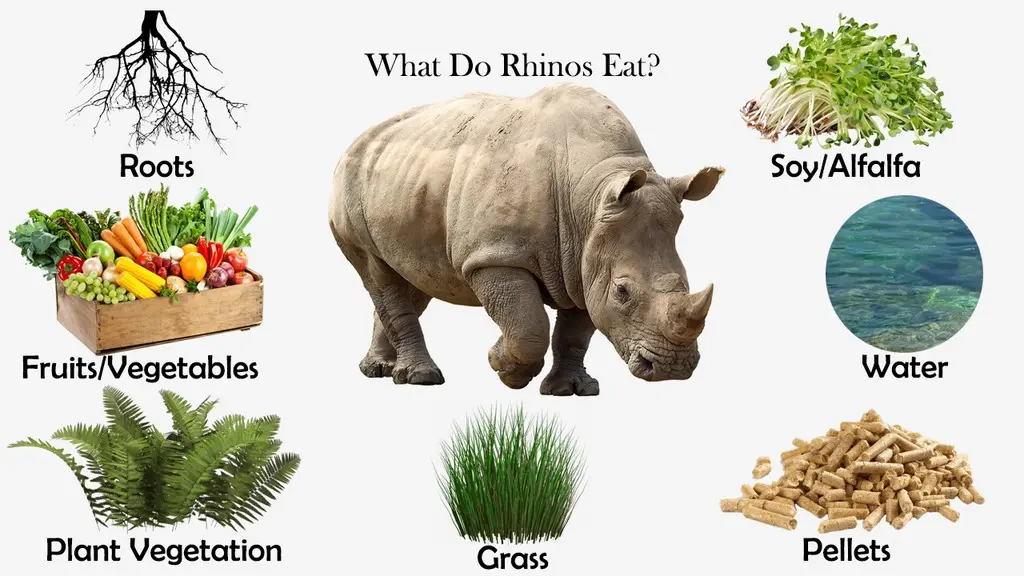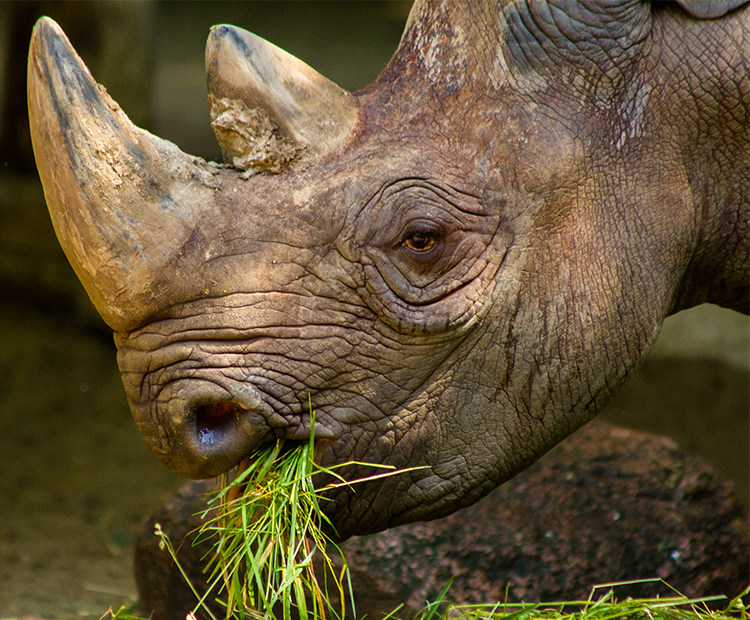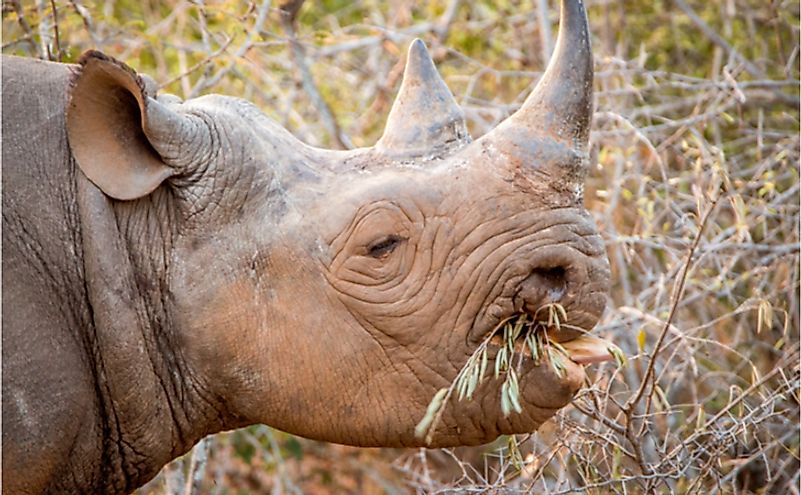Meals for rhino is a vital facet of their survival, shaping their conduct, habitat, and conservation efforts. From their distinctive dietary must the challenges they face resulting from habitat loss, this text delves into the fascinating world of rhino vitamin and its implications for his or her well-being.
Understanding the dietary necessities of rhinos, their feeding habits, and the impression of habitat availability on their meals assets supplies helpful insights into the conservation methods wanted to guard these magnificent creatures.
Dietary Wants of Rhinos

Rhinos are giant, herbivorous mammals which have particular dietary necessities. Their eating regimen consists primarily of vegetation, and they’re recognized for his or her potential to eat giant quantities of meals every day.
Rhinos have a digestive system that’s tailored to interrupt down powerful plant materials. Their tooth are designed to grind up leaves, stems, and different plant matter. In addition they have a big abdomen that permits them to retailer meals and ferment it earlier than it’s digested.
Kinds of Meals Rhinos Eat
The eating regimen of a rhino varies relying on the species and the habitat wherein it lives. Nonetheless, all rhinos eat a wide range of plant materials, together with:
- Grasses
- Leaves
- Stems
- Fruits
- Bark
Some rhinos additionally eat bugs and small animals, however this isn’t a serious a part of their eating regimen.
Significance of Fiber in Rhino Weight loss program
Fiber is a crucial a part of a rhino’s eating regimen. It helps to maintain the digestive system wholesome and functioning correctly. Fiber additionally helps to fill rhinos up and preserve them feeling glad after consuming.
Rhinos have to eat a eating regimen that’s excessive in fiber as a way to keep wholesome. A eating regimen that’s low in fiber can result in digestive issues, reminiscent of constipation and diarrhea.
Feeding Habits of Rhinos
Rhinos are herbivores, that means they primarily feed on plant matter. Their eating regimen consists of a wide range of grasses, leaves, fruits, and shoots. They’re recognized for his or her giant appetites and may eat as much as 200 kilos of meals per day.Rhinos
have a singular feeding sample that entails each grazing and shopping. Grazing refers back to the consumption of grasses and different low-growing vegetation. Looking, however, entails consuming leaves, twigs, and fruits from timber and shrubs. Rhinos sometimes spend most of their time grazing, however they are going to complement their eating regimen with shopping when mandatory.Rhinos
have a wonderful sense of odor that helps them find meals. They’ll detect the scent of vegetation from a fantastic distance and can usually journey lengthy distances to achieve their desired feeding grounds. As soon as they discover a appropriate meals supply, they are going to use their highly effective jaws and tooth to tear and chew the vegetation.
Grazing, Meals for rhino
Grazing is the first feeding methodology for rhinos. They use their giant, prehensile lips to understand and tear grasses and different low-growing vegetation. Rhinos should not notably selective of their grazing habits and can eat all kinds of grasses, together with each native and non-native species.
Looking
Rhinos can even browse on leaves, twigs, and fruits from timber and shrubs. Looking is often accomplished along with grazing and helps to complement the rhino’s eating regimen with vitamins that will not be obtainable in grasses. Rhinos are recognized to browse on a wide range of plant species, together with acacia, willow, and fig timber.
Habitat and Meals Availability

The habitat wherein rhinos reside performs a vital function in figuring out their meals availability. Rhinos inhabit various ecosystems, starting from grasslands and savannas to forests and wetlands. Every habitat presents a singular array of vegetation, influencing the feeding habits of rhinos.
Habitat loss, primarily pushed by human actions reminiscent of deforestation, agriculture, and urbanization, poses a major menace to rhinos. As their pure habitats shrink, rhinos face lowered entry to their most well-liked meals sources. This will result in dietary deficiencies, weight reduction, and elevated vulnerability to illnesses.
Adaptation to Modifications in Meals Availability
Rhinos have advanced sure diversifications to deal with modifications in meals availability. These diversifications embody:
- Dietary Flexibility:Rhinos should not strictly herbivores and may eat a variety of plant materials, together with grasses, leaves, twigs, fruits, and even bark. This dietary flexibility permits them to adapt to various meals sources.
- Foraging Methods:Rhinos have developed environment friendly foraging methods to maximise their meals consumption. They use their eager sense of odor to find meals and may journey lengthy distances in the hunt for appropriate grazing areas.
- Intestine Diversifications:Rhinos possess a specialised digestive system that permits them to effectively extract vitamins from the powerful, fibrous vegetation they eat. Their giant cecum, a fermentation chamber within the digestive tract, allows them to interrupt down cellulose and procure power from plant materials.
Conservation Implications

Meals availability is essential for rhino conservation because it immediately impacts their survival, replica, and total well-being. Guaranteeing satisfactory meals assets is important to keep up wholesome rhino populations and stop inhabitants declines.Captive breeding applications play an important function in guaranteeing meals safety for rhinos.
These applications present managed environments the place rhinos can entry nutritious diets tailor-made to their particular wants. Captive breeding additionally helps protect genetic range, which is essential for long-term species survival.
Conservation Efforts for Enhancing Meals Assets
Conservation efforts geared toward bettering meals assets for rhinos embody:
Habitat restoration and administration
Defending and restoring rhino habitats ensures the provision of pure meals sources. This entails controlling invasive species, stopping deforestation, and establishing corridors to attach fragmented habitats.
Supplemental feeding
In areas the place pure meals assets are scarce, supplemental feeding applications present extra vitamin to rhinos. This will contain offering hay, browse, or mineral dietary supplements to help their dietary wants.
Translocations
Translocations contain shifting rhinos to new areas with extra considerable meals assets. This might help alleviate strain on present habitats and cut back competitors for meals amongst rhinos.
Fast FAQs: Meals For Rhino
What are the distinctive dietary necessities of rhinos?
Rhinos are herbivores with a eating regimen primarily consisting of grasses, leaves, twigs, and fruits. Their digestive system is tailored to ferment powerful plant materials, they usually require a excessive consumption of fiber to keep up a wholesome intestine.
How do rhinos use their sense of odor to find meals?
Rhinos have an acute sense of odor, which they use to detect meals sources from a distance. They’ll establish particular vegetation and fruits by their scent, they usually usually depend on their sense of odor to navigate their habitat in the hunt for meals.
What are the conservation implications of meals availability for rhinos?
Meals availability is a important consider rhino conservation. Habitat loss and degradation can considerably cut back meals assets, resulting in malnutrition, lowered replica, and elevated susceptibility to illnesses. Conservation efforts usually concentrate on defending and restoring rhino habitats to make sure satisfactory meals availability.

